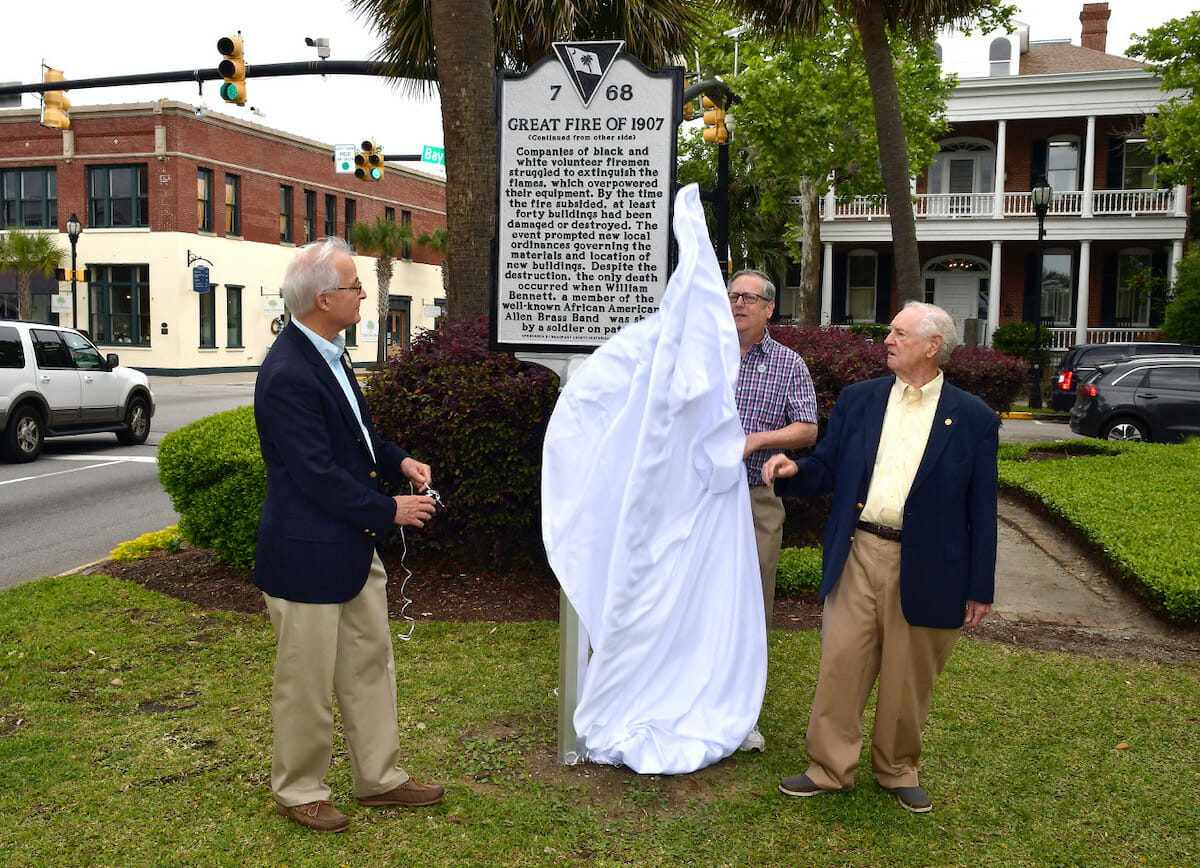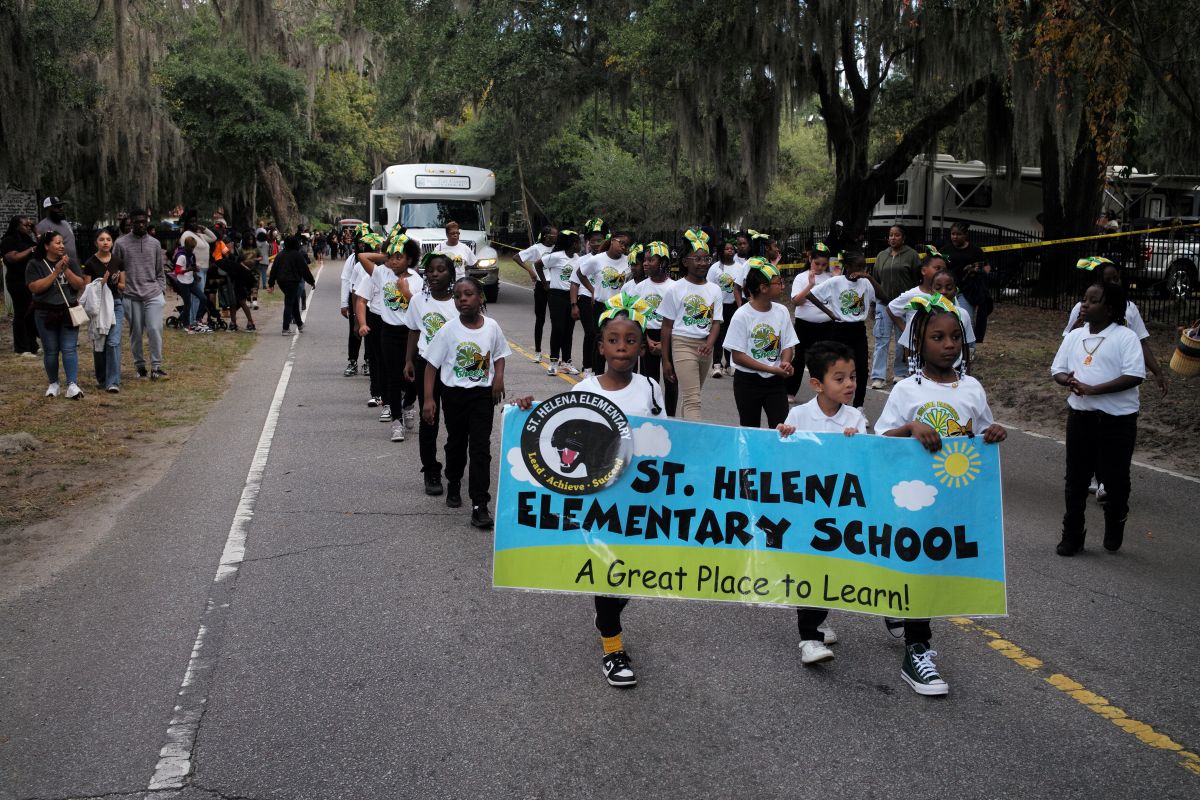Beaufort memorializes devastating fire with marker
By Tony Kukulich
A new marker commemorating the Great Fire of 1907 was unveiled by the Beaufort County Historical Society (BCHS) in Stephen Elliot Park last week where it joined 66 other historic markers located throughout the county.
The fire represents one of the defining moments in Beaufort’s long history. It got its start near the corner of Bay and Carteret streets — just across the street from where the new marker stands — and destroyed more than 40 structures before it was extinguished.
“There was a lot of interest in that particular event and how much it impacted Beaufort,” said Leah Roche with the BCHS. “It’s been on the backburner for a while. Our researcher, Linda (Hoffman), put the pieces together in a way that was accepted by the South Carolina Department of Archives and History, which has to approve all of these markers.”
After the BCHS’s research was approved by the state, the text for the marker was sent to a foundry in Marietta, Ohio, where the marker was cast at a cost of $2,170.
Larry Rowland, distinguished professor emeritus of history for the University of South Carolina Beaufort and BCHS president, provided a brief history of the fire before marker’s unveiling. According to Rowland, the conflagration had its start with three boys sneaking cigarettes and trying to stay out of an icy wind blowing at 30 knots on a mid-January morning.
“There was a warehouse down by the water where the park is now,” Rowland explained. “It was a cotton warehouse that was mostly empty. It was a wooden building made out of heart pine, very susceptible to fire. The boys started a little bonfire to keep warm. Well, that wasn’t a smart idea. Evidently, it caught the lint on fire and blew it into the walls of the heart pine building, and kaboom. Because the wind was so strong, the fire was like a blow torch.”
The Stevens Building, which stood on the spot now occupied by Merrill Lynch, was the next to burn. It housed F.W. Scheper’s store and ship chandlery downstairs while upstairs was the Harmony Lodge of Freemasons, which lost all of its historical records.
As the fire grew, it was pushed north on Carteret Street by the wind coming up from the south.
“One building after another on both sides of the street was burned,” Rowland said. “It marched all the way up to where the Carteret Street Methodist Church is. The fire didn’t go east and west. It went north and burned everything on several blocks.”
In addition to the main body of the fire, embers cast forward by the wind burned homes and businesses unfortunate enough to be positioned where those embers finally came to rest.

“It was just odd,” said Rowland. “A lot of things beyond the core of the fire were burned. It was a big disaster, and the property losses were great.”
The only fatality related to the fire was William Bennett, a Black musician well known across Beaufort. Bennett was not a victim of fire or smoke. He was shot by a National Guardsman for violating the curfew. The shooting of Bennett was so egregious that the guardsman was put on trial for manslaughter, though he was eventually acquitted.
A Black fire department from the Northwest Quadrant and a White fire department located on Craven and Scott streets spent the day battling the blaze together. Both agencies maintained a long-standing friendly rivalry, competing to be the first agency to get water on city fires. The cooperation between the agencies in the face of the fire was an inspiration to the residents of the city, Rowland said. Much of that goodwill evaporated in the wake of Bennett’s killing.
The fire started around 10 a.m. and by the late afternoon, the worst of it was over. The city, however, was forever changed. Though it’s been 115 years since the Great Fire, its impact is still felt today, particularly in the city’s fire code. Beaufort City Council member Neil Lipsitz noted that the city currently enjoys a top fire rating.
“Improper disposal of smoking material is still a leading cause of fire today, even though we’ve come a long way in fire prevention and education efforts since the 1900s,” Fire Chief Tim Ogden said. “The Beaufort/Port Royal Fire Department currently monitors for improper disposal of smoking material downtown through the Fire Prevention and Inspection Program. We walk the streets and put the word out on fire safety regularly downtown to help prevent such a devastating fire such as the 1907 Beaufort fire.”
Tony Kukulich is a recent transplant to the Lowcountry. A native of Wilmington, Del., he comes to The Island News from the San Francisco Bay Area where he spent seven years as a reporter and photographer for several publications. He can be reached at tony.theislandnews@gmail.com.








